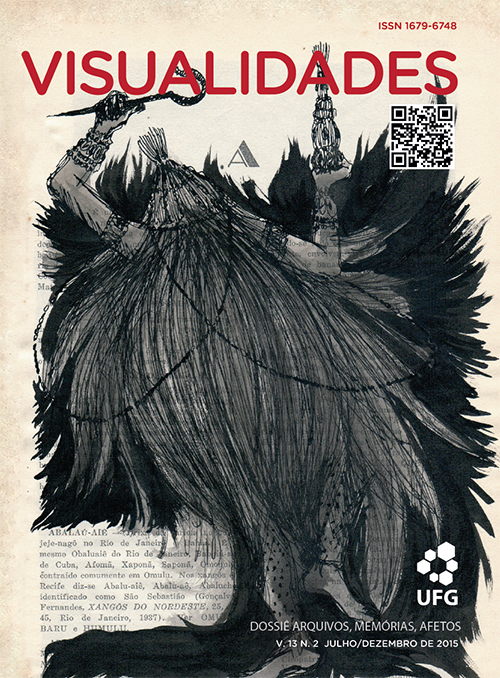Hypervisibility and self-disclosure: new textures of social experience in the social networks
DOI:
https://doi.org/10.5216/vis.v13i2.34196Abstract
The emergence of social networks has changed the forms of expression and socialization in contemporary societies, influencing the ways in which we relate to the other and to the visualities. Today, people are learning to manage qualitatively aspects of their identity to be posted in social interfaces and experimenting new placements of gender and sexuality. The reflections of the article come from the partial results of the doctoral research. The article examines the practices of see and be seen in social networks, in particular, focusing on two vital issues in order to understand the experiences from the digital perspective: hypervisibility and self-disclosure.
Keywords: hypervisibility, self-disclosure, social networks
Downloads
References
ALEXANDER, ; LOSH,. A YouTube of One's Own? In: PULLEN, C.; COOPER , M. LGBT Identity and Online New Media. New York: Routledge, 2010. p. 37-50.
BAUDRILLARD, J. Cultura y simulacro. Tradução de Pedro Rovira. Barcelona: Kairós, 1978.
BELLI, S. Emociones y lenguaje. Universidad Autònoma de Barcelona. Barcelona. 2009.
BINNIE, J. The globalization of sexuality. London: Sage, 2004. 167 p. ISBN: 9780761959366.
boyd, d. Dear Voyeur, meet Flâneur… Sincerely, Social Media. Surveillance & Society, 8, n. 4, 2011. 505-507. Disponivel em: <http://www.surveillance-and-society.org>. Acesso em: 10 jun. 2011.
boyd, d.; ELLISON, N. B. Social network sites: Definition, history, and scholarship. Journal of Computer-Mediated Communication, 13, n. 1, 17 Deciembre 2008. 210–230. Disponivel em: <http://www.danah.org/papers/JCMCIntro.pdf>. Acesso em: 25 fev. 2014. article 11.
BRUNER, J. La fábrica de historias: Derecho, literatura, vida. Buenos Aires: Fondo de Cultura Económica, 2003.
BYUNG-CHUL, H. La sociedad de la transparencia. Tradução de Raúl Gabas. Barcelona: Herder Editorial, 2013.
CONELLY , M.; CLANDININ, J. Relatos de Experiencia e Investigación Narrativa. In: LARROSA, J. Déjame que te cuente. Ensayos sobre narrativa y educación. Barcelona: Laertes, 1995. p. 11-59.
ECO, U. La estrategia de la ilusión. Tradução de Edgardo Oviedo. Barcelona: DeBolsillo, 2012. ISBN: 9788499895109.
EGAN,. Lonely gay teen seeking same. The New York Times Magazine, 10 dez. 2000. 110-113. Disponivel em: <http://www.nytimes.com/2000/12/10/magazine/lonely-gay-teen-seeking-same.html>. Acesso em: 15 nov. 2013.
GROSS, L. Forword. In: O’RIORDAN, K.; PHILLIPS , D. J. Queer Online: Media, Technology and Sexuality. [S.l.]: Peter Lang Publishing, 2007. p. vii–x.
HERNÁNDEZ, F. ¿De qué hablamos cuando hablamos de cultura visual? Educação e Realidade, 30, n. 2, jul/dez 2005. 9-34.
HERNÁNDEZ, F. Espigador@s de la Cultura visual. Otra narrativa para la educación de artes visuales. Barcelona: Octaedro, 2007.
HERNÁNDEZ, F. Transitar y aprender dentro y fuera de la escuela: la relación de los jóvenes con la cultura visual como espacio de posibilidad y autoría. In: EDARTE Investigar con jóvenes: ¿Qué sabemos de los jóvenes como productores de cultura visual? Pamplona: Pamiela – Edarte (UPNA/NUP), 2013b. p. 83-92.
ÍÑIGUEZ, L.; BELLI, S.; HARRÉ, R. Tecnoemociones y discurso: la performance emocional. Revista Electrónica de Motivación y Emoción, España, 13, n. 34, 2010. 1-31. Disponivel em: <http://reme.uji.es/articulos/numero34/article6/texto.html>. Acesso em: 30 mar. 2014. ISSN-e 1138-493X.
KEEN, A. Vertigem digital: por que as redes sociais estão nos dividindo, diminuindo e desorientando? Tradução de Alexandre Martins. Rio de Janeiro: Zahar, 2012.
MEHDIZADEH,. Self-Presentation 2.0: Narcissism and Self-Esteem on Facebook. Cyberpsychology, Behavior, and Social Networking, 13, n. 4, August 2010. 357-364.
MITCHELL, W. J. T. Picture Theory. Chicago: The University of Chicago Press, 1994.
QIAN, H.; SCOTT, C. R. Anonymity and self-disclosure on weblogs. Journal of Computer-Mediated Communication, 12, n. 4, July 2007. 1428-1451.
SONTAG, S. Sobre La Fotografia. Tradução de Carlos Gardini e Aurelio Major. México: Sancillana Ediciones Generales, 2006.
Downloads
Published
How to Cite
Issue
Section
License

This work is licensed under a Creative Commons Attribution 4.0 International License .
Authors who publish in this journal agree to the following terms:
a. Authors retain the copyright and grant the journal the right of first publication, with the work simultaneously licensed under the Creative Commons Attribution 4.0 License which allows the sharing of work with acknowledgment of authorship and initial publication in this journal.
b. Authors are authorized to take additional contracts separately, for non-exclusive distribution of the version of the work published in this journal (eg publish in institutional repository or as a book chapter), with acknowledgment of authorship and initial publication in this journal.
c. Authors are allowed to publish and distribute their work online (eg in institutional repositories or on their personal page) after the initial publication in this journal, as this can generate productive changes, as well as increase the impact and citation of the published work ( See The Effect of Free Access).
Every effort has been made to identify and credit the rights holders of the published images. If you have rights to any of these images and have not been correctly identified, please contact the Visuals magazine and we will publish the correction in one of the next issues.






